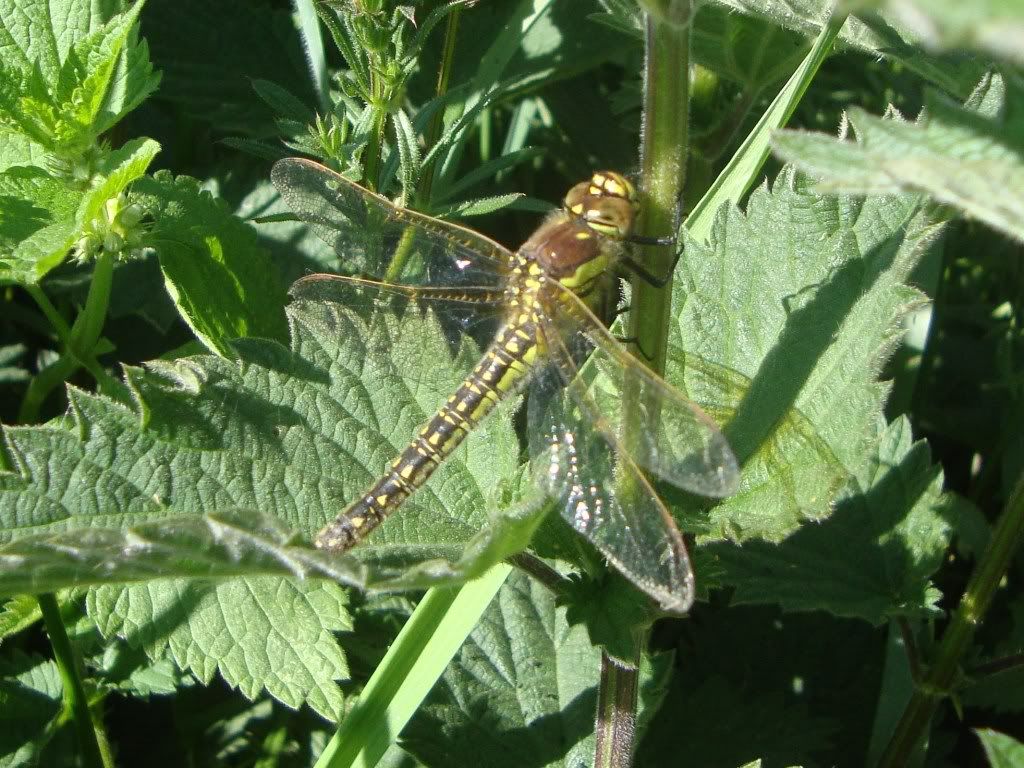This is without a doubt the hardest blog entry I've ever had to write, and that is because it's my last.
I've been blogging now since March 2007, and when it comes time to put fingertips to keyboard I do sometimes struggle for inspiration.
Sometimes I pore over the lyrics to some of my favourite songs. Other times I'll delve into obscure poetry. Heck, you'll even recall that I had to dig some Jack Kerouac recently to get the old grey matter flowing, and I'm not sure I've completely got over the experience.
Yep, it's hard work - partly because in recent times I've looked to produce something a bit leftfield, atypical from the stuff you normally see on these kind of sites. And when I've managed to achieve that, it has been very rewarding. The comments and feedback I've had over the last three or so years, positive and negative, have been much appreciated.
If I've made you laugh, cry, sympathise, get angry, or get out there birding, butterflying or mothing, then I suppose I have achieved my goal. If I have failed to provoke a reaction of any sort, then I have indeed bogged it up good and proper.
Musical genius and legendary berserker Mike Oldfield once said that he likes to shed his skin every few years, and I have a tendency to do the same. I'm not hanging up the binoculars or mothballing the moth trap just yet, and I fully expect to continue enjoying the outdoors and wildlife for many a good year to come, but I definitely think that Eye To The Telescope has reached a natural conclusion and it is time to lay it to rest.
I had planned to continue until the end of the year, but why prolong the inevitable? For the sake of my own sanity, I think now is the right time to call it a day.
I recently saw an amazing, young musician at the Glee Club in Birmingham. His name is Ben Howard. I'd never heard of him before, but as soon as he started playing his guitar and singing, I knew I was in the presence of genius.
I leave you with some of his lyrics, taken from the song These Waters. Being the sentimental old fool that I am, I like to associate music with events from my life, and I think this tune will be a fitting reminder to me of the many happy hours I have spent writing about my time in the field. A massive thank you to everyone who has dropped in and shared my experiences over the past few years. Until we meet again, happy birding.
These Waters - Ben Howard
And through it all,
I stood and stumbled, waded through my thoughts and heart
Yeah through it all,
I fooled and fumbled, lost to the poet's frown.
I fought the wolves of patience just to let it lie down
And what we found
Down these coves of limestone and cockle shells,
What we found
Down these roads that wander as lost as the heart,
Is a chance to breathe again, a chance for a fresh start
Sunday, October 3, 2010
Sunday, August 22, 2010
The Butterfly Effect - August 2010
For those of you who found last month's Kerouac-inspired blog entry a tad bizarre, you'll be pleased to here that my promise to base August's missive on Dylan Thomas' Under Milkwood was just a joke. So rest assured - there'll be no mention of the fishingboatbobbing sea, Captain Cat, nor any references to neddying among the snuggeries of babies, whatever the hell that means!

Dylan Thomas - berserker
Having said that, I have been down to Grafton Wood this month. Grafton Wood ... Milkwood - I'm sure there must be some puns to be had somewhere in there. Glancing through the first few paragraphs of the Welsh scribe's prose, I also see mention of Curlew, Skylark and Cormorant, and I distinctly recall a line that goes, "... sung like a linnet".
A missed opportunity maybe? Oh well, another time perhaps ...
So, back to Grafton Wood then. No Telescope points for guessing that I went there in search of Brown Hairstreaks, this being one of the places in the country, let alone the Midlands, to see them.
The number of butterflies in the wood was truly amazing. More Common Blues than you could shake a stick at, plus all the other usual species you'd expect - Gatekeepers, Green-veined Whites, that sort of thing. Then I picked out my first ever Brown Argus, which I always thought I'd struggle to ID correctly, but which in the field is actually quite easy once you know what to look for.

Brown Argus
They're a bit smaller than Common Blues [though female Common Blues are pretty titchy themselves] and they have a distinctly different kind of flight. I could try and describe it, but I'd end up using words like flitty, so I won't bother.
I also think they look a shade paler on the underwing in flight. Once you get a proper look at the wing markings, there should be no doubt - the Brown Argus, as its name suggests, is brown, lacking the blue colouration on the upperwing that a female Common Blue has.
Female Common Blues also have some white mixed in with the orange marks on the edge of the hindwing. The following photo shows this well.

Female Common Blue
I haven't got any great shots of the underwing, but if you get a good look at this you'll see that the Common Blue has an obvious extra spot on the underside of the forewing. There are other subtle differences, but the ones I've mentioned are those that helped me sort them out.
Shortly afterwards I discovered my first ever Purple Hairstreak, which had come down from the oak trees and was loafing around on some beech. Out of camera shot unfortunately, but it afforded half-decent views for a minute or so, before disappearing back up towards the canopy.
I continued on, noting more and more species, like Brimstone and Peacock. It might be easier to list those that I didn't see. Also, there were several Southern Hawker dragonflies and a few Common Darters, plus some day-flying Silver Y moths. I was in my element.
However, still no sign of any Brown Hairstreaks ...
I bumped into another butter-nutter, who said he had had no joy with the hairstreaks either, but he had seen a White Admiral and a Dark Green Fritillary [... the butterfly we never found], so I went off in search of those [two more potential lifers, I might add!].
I found the White Admiral without too much trouble, but the Dark Green Fritillary eluded me once more. I did, however, find this extremely tatty Silver-washed Fritillary, apparently of the form valesina, as it had no orange colour to it at all. It still flew quite well despite missing large portions of its wings, but certainly wasn't as flighty as those that I've seen in their pomp in the Wyre Forest.

Silver-washed Fritillary [presumed valesina form]

White Admiral
I left without having seen any Brown Hairstreaks, but I was content with the three lifers. I will be back again next year for another go. There is an organised walk in a couple of weeks' time, but I'd rather find them myself to be honest. Whilst having one last search for the elusive insects, I did spy a Migrant Hawker dragonfly though. A nice bonus.
I had intended to do a bit of twitching the following day, but there was little on offer in the way of birds, so I hatched a plan to go out butterflying again. This time I went down to Aston Rowant, which is a stronghold for the Silver-spotted Skipper. The Chalkhill Blue also frequents this site, and there was always the possibility of a late Essex Skipper, so hopes were high.
Silver-spotted Skipper and Chalkhill Blue were relatively easy to spot once the sun came out, and one of each species was even kind enough to pose for some photos. Also on site, more Common Blues, Brown Argus, Small Copper and a Brimstone or two, but no sign of any Essex Skipper. Plenty of Red Kites in the area too - a bird that I always enjoy seeing.


Silver-spotted Skipper

Chalkhill Blue
Ironically, what I think may have been a Dark Green Fritillary flew through the car park as I was munching on a piece of pork pie. It had gone before I could get the bins up to get a closer look.
It seems that this species is turning out to be my bogey - albeit one that I intend to pick next year in Devon.
Until then, it remains ... the butterfly we never found.
Snake, Rattle & Roll
I had hoped to include a short video that I took at work of a grass snake. I've seen two or three over the past few years, but this is the first that I've managed to catch on camera. Sadly, I can't seem to get the file into a workable format, but if you meet me out in the field, I'll be happy to show you the footage!
The grounds at work have been delivering the goods on a regular basis recently - Banded Demoiselle, Azure, Common Blue, Blue-tailed and Large Red Damselflies have all been present this summer, along with Southern and Brown Hawker dragonflies and a Common Darter or two. The better butterflies have included Common Blue, Marbled White and Small Skipper.
Speaking of damselflies, I must take a minute to mention Graham Sherwin. Graham has produced an excellent DVD, available from his website:
http://www.gswildlife.co.uk/index.html
The DVD was reviewed in a recent edition of Birdwatching magazine and I became the proud owner of a copy this month. If you are into dragons and damsels, then this really is a treat - excellent footage and loads of tips to help ID the various species in the field. Heartily recommended.
The dragonfly equivalent should be out next year and already looks like being another essential purchase.
News From The Trap
The mothing has continued this month, although the weather has meant the trap has been out a bit less than usual. Still, I have bagged a few more lifers - Copper Underwing, Svensson's Copper Underwing, Broad-bordered Yellow Underwing, Chocolate-tip and Sallow Kitten.
I'm not really sure how long the moth season lasts for, but I will keep putting out the trap until numbers tail off. I have manufactured a rain guard now, so I am more inclined to do a bit of mothing even if there is a threat of rain.
Next month I hope to have more bird news. There should be some goodies moving through the Midlands in the next few weeks and I am keen to bag a few more lifers if they present themselves.

Dylan Thomas - berserker
Having said that, I have been down to Grafton Wood this month. Grafton Wood ... Milkwood - I'm sure there must be some puns to be had somewhere in there. Glancing through the first few paragraphs of the Welsh scribe's prose, I also see mention of Curlew, Skylark and Cormorant, and I distinctly recall a line that goes, "... sung like a linnet".
A missed opportunity maybe? Oh well, another time perhaps ...
So, back to Grafton Wood then. No Telescope points for guessing that I went there in search of Brown Hairstreaks, this being one of the places in the country, let alone the Midlands, to see them.
The number of butterflies in the wood was truly amazing. More Common Blues than you could shake a stick at, plus all the other usual species you'd expect - Gatekeepers, Green-veined Whites, that sort of thing. Then I picked out my first ever Brown Argus, which I always thought I'd struggle to ID correctly, but which in the field is actually quite easy once you know what to look for.

Brown Argus
They're a bit smaller than Common Blues [though female Common Blues are pretty titchy themselves] and they have a distinctly different kind of flight. I could try and describe it, but I'd end up using words like flitty, so I won't bother.
I also think they look a shade paler on the underwing in flight. Once you get a proper look at the wing markings, there should be no doubt - the Brown Argus, as its name suggests, is brown, lacking the blue colouration on the upperwing that a female Common Blue has.
Female Common Blues also have some white mixed in with the orange marks on the edge of the hindwing. The following photo shows this well.

Female Common Blue
I haven't got any great shots of the underwing, but if you get a good look at this you'll see that the Common Blue has an obvious extra spot on the underside of the forewing. There are other subtle differences, but the ones I've mentioned are those that helped me sort them out.
Shortly afterwards I discovered my first ever Purple Hairstreak, which had come down from the oak trees and was loafing around on some beech. Out of camera shot unfortunately, but it afforded half-decent views for a minute or so, before disappearing back up towards the canopy.
I continued on, noting more and more species, like Brimstone and Peacock. It might be easier to list those that I didn't see. Also, there were several Southern Hawker dragonflies and a few Common Darters, plus some day-flying Silver Y moths. I was in my element.
However, still no sign of any Brown Hairstreaks ...
I bumped into another butter-nutter, who said he had had no joy with the hairstreaks either, but he had seen a White Admiral and a Dark Green Fritillary [... the butterfly we never found], so I went off in search of those [two more potential lifers, I might add!].
I found the White Admiral without too much trouble, but the Dark Green Fritillary eluded me once more. I did, however, find this extremely tatty Silver-washed Fritillary, apparently of the form valesina, as it had no orange colour to it at all. It still flew quite well despite missing large portions of its wings, but certainly wasn't as flighty as those that I've seen in their pomp in the Wyre Forest.

Silver-washed Fritillary [presumed valesina form]

White Admiral
I left without having seen any Brown Hairstreaks, but I was content with the three lifers. I will be back again next year for another go. There is an organised walk in a couple of weeks' time, but I'd rather find them myself to be honest. Whilst having one last search for the elusive insects, I did spy a Migrant Hawker dragonfly though. A nice bonus.
I had intended to do a bit of twitching the following day, but there was little on offer in the way of birds, so I hatched a plan to go out butterflying again. This time I went down to Aston Rowant, which is a stronghold for the Silver-spotted Skipper. The Chalkhill Blue also frequents this site, and there was always the possibility of a late Essex Skipper, so hopes were high.
Silver-spotted Skipper and Chalkhill Blue were relatively easy to spot once the sun came out, and one of each species was even kind enough to pose for some photos. Also on site, more Common Blues, Brown Argus, Small Copper and a Brimstone or two, but no sign of any Essex Skipper. Plenty of Red Kites in the area too - a bird that I always enjoy seeing.


Silver-spotted Skipper

Chalkhill Blue
Ironically, what I think may have been a Dark Green Fritillary flew through the car park as I was munching on a piece of pork pie. It had gone before I could get the bins up to get a closer look.
It seems that this species is turning out to be my bogey - albeit one that I intend to pick next year in Devon.
Until then, it remains ... the butterfly we never found.
Snake, Rattle & Roll
I had hoped to include a short video that I took at work of a grass snake. I've seen two or three over the past few years, but this is the first that I've managed to catch on camera. Sadly, I can't seem to get the file into a workable format, but if you meet me out in the field, I'll be happy to show you the footage!
The grounds at work have been delivering the goods on a regular basis recently - Banded Demoiselle, Azure, Common Blue, Blue-tailed and Large Red Damselflies have all been present this summer, along with Southern and Brown Hawker dragonflies and a Common Darter or two. The better butterflies have included Common Blue, Marbled White and Small Skipper.
Speaking of damselflies, I must take a minute to mention Graham Sherwin. Graham has produced an excellent DVD, available from his website:
http://www.gswildlife.co.uk/index.html
The DVD was reviewed in a recent edition of Birdwatching magazine and I became the proud owner of a copy this month. If you are into dragons and damsels, then this really is a treat - excellent footage and loads of tips to help ID the various species in the field. Heartily recommended.
The dragonfly equivalent should be out next year and already looks like being another essential purchase.
News From The Trap
The mothing has continued this month, although the weather has meant the trap has been out a bit less than usual. Still, I have bagged a few more lifers - Copper Underwing, Svensson's Copper Underwing, Broad-bordered Yellow Underwing, Chocolate-tip and Sallow Kitten.
I'm not really sure how long the moth season lasts for, but I will keep putting out the trap until numbers tail off. I have manufactured a rain guard now, so I am more inclined to do a bit of mothing even if there is a threat of rain.
Next month I hope to have more bird news. There should be some goodies moving through the Midlands in the next few weeks and I am keen to bag a few more lifers if they present themselves.
Tuesday, July 20, 2010
The Birding Month - July 2010
I've been reading a lot of Jack Kerouac this month, and this blog entry is inspired by and is in the style of his most famous novel, On The Road. Pictures follow, which will probably make more sense!
With the coming of July began the part of my life you could call my week's vacation in Wales. Mrs Reg was my companion. Mrs Reg was a pretty blonde with immense ringlets of hair like a sea of golden tresses. The following seven days were, as W. C. Fields said, 'fraught with eminent peril' - and some top-quality wildlife. Somewhere along the line I knew there'd be birds, moths, everything; somewhere along the line the pearl would be handed to me.
We were in Criccieth now.
The gulls danced down the seafront like dingledodies, and I shambled after as I've been doing all my life after birds that interest me, because the only birds for me are the mad ones, the ones who are mad to live, mad to talk, mad to be saved, desirous of everything at the same time, the ones who never yawn or do a commonplace thing, but burn, burn, burn like fabulous yellow roman candles exploding like spiders across the stars and in the middle you see the blue centerlight pop and everybody goes 'Awww!' What did they call such birds in Goethe's Germany? Schwarzschnabel-sturmtaucher? Strandpieper? Baßtölpel?
Then came Monday, the time of unsuccessful butterfly hunting among the dunes near Caernarfon. I didn't have enough gen to find the Dark Green Fritillary. I figured to worry about that when I got to Dinas Dinlle.
We walked around aimlessly awhile. 'What the hell am I doing up here?' I cursed. I began crying and swearing and socking myself on the head for being such a damn fool. The sun began to get red. Nothing had been accomplished. What was there to accomplish? 'Mañana,' said Mrs Reg. 'Mañana, man, we make it; have another Pimms and lemonade, man, dah you go, dah you go!'
One last glimpse of Dinas Dinlle across the hot lights of the Dingles Restaurant & Bar, and we turned our back and fender to it and roared off. Nothing happened that night; we went to sleep. Everything happened the next day.
First thing I did was go out across the cornfield to check the moth trap. Mullein Wave, Coxcomb Prominent and True Lover's Knot were all new.
It was mid-morning. And how can homely afternoons in Llangybi with its farms and stone walls and St Cybi's well - the little places where spotted flycatchers breed - produce a moth like the moth that spooked Mrs Reg? She was in the back garden talking happily when suddenly a Large Yellow Underwing flew into her arm and made her howl. It had come out of one of my egg boxes.
She yanked and slapped at her arm and tripped over the step, and in a few minutes her arm had begun to swell and hurt. 'Damn!' It made the trip seem sinister and doomed. We went to the bathroom and put some Savlon and a plaster on it.
That evening we went into an Indian restaurant and had shish kebabs and chicken jalfrezi with boiled rice; it was delicious. It had been a long day.
Wednesday. It was time for us to move on. In no time at all we were back on the main highway, heading for Nefyn. It was drizzling and mysterious at the beginning of our journey.
There were the most beautiful bevies of birds everywhere I looked in Porth Dinllaen that afternoon - guillemots, kittiwakes, sandwich terns - but I had no time for thoughts like that and promised myself a bit more mothing the following evening.
And as I sat there listening to that sound of the summer night which the Big Brother theme music has come to represent for all of us, I thought of all the moths from one end of the country to the other and how they were really all in the same vast backyard doing something so frantic and rushing-about.
The air was soft, the stars so fine, the promise of every new moth so great, that I thought I was in a dream.
Whither goest thou, Early Thorn, in thy shiny car in the night?
I like too many things and get all confused and hung-up running from one new moth to another till I drop. This is the night, what it does to you. I had nothing to offer anybody except my own confusion.
In myriad pricklings of heavenly radiation I had to struggle to see a Burnished Brass, and it looked like God. I saw that my life list was a vast glowing empty page and I could do anything I wanted.
Friday. We zoomed through Chwilog, over the River Dwyfor at Llanystumdwy, and straight for Criccieth. And here for the first time in my life I saw my beloved storm petrel, white rump in the summer gloom, flicky-winged, disappearing over the waves. A pain stabbed my heart, as it did every time I saw a bird I loved who was going the opposite direction in this too-big world.
I ate carrot cake and ice cream - it was getting better as I got deeper into the holiday.
Now we resumed the road to the magic field. The great mountains rose snow-capped before us; we bowled right for them. Behind us lay the whole of Llangybi and everything Mrs Reg and I had previously known about life, and life on the road. We had finally found the magic field at the end of the road and we never dreamed the extent of the magic - a Golden-ringed Dragonfly. I tingled all over from head to foot.
So in Criccieth when the sun goes down and I sit on the old broken-down river pier watching the long, long skies over Abersoch and sense all that raw land that rolls in one unbelievable huge bulge over to Anglesey, and all that road going, all the people dreaming in the immensity of it, and in Porthmadog I know by now the children must be crying in the land where they let the children cry, and tonight the stars'll be out, and don't you know that God is Pooh Bear? the evening star must be drooping and shedding her sparkler dims on the magic field, which is just before the coming of complete night that blesses the earth, darkens all rivers, cups the peaks and folds the final shore in, and nobody, nobody knows what's going to happen to anybody besides the forlorn rages of growing old, I think of the Dark Green Fritillary, I even think of the Dark Green Fritillary the butterfly we never found, I think of the Dark Green Fritillary.

Willow warbler - taken by Mrs Reg

Rock pipit digi-scoped at Criccieth beach

Antler Moth

Small Magpie

Buff Arches

Small Copper

Cinnabar caterpillar

Coxcomb Prominent

Garden Tiger

Grayling at Porth Dinllaen

Grey Seal at Porth Dinllaen

Burnished Brass

Early Thorn

Grasshopper warbler - digi-scoped near Llangybi

Dead moles - macabre

Meadow Brown

Golden-ringed Dragonfly
Thank you for indulging me. Next month's blog entry will be in the style of Under Milkwood by Dylan Thomas.
With the coming of July began the part of my life you could call my week's vacation in Wales. Mrs Reg was my companion. Mrs Reg was a pretty blonde with immense ringlets of hair like a sea of golden tresses. The following seven days were, as W. C. Fields said, 'fraught with eminent peril' - and some top-quality wildlife. Somewhere along the line I knew there'd be birds, moths, everything; somewhere along the line the pearl would be handed to me.
We were in Criccieth now.
The gulls danced down the seafront like dingledodies, and I shambled after as I've been doing all my life after birds that interest me, because the only birds for me are the mad ones, the ones who are mad to live, mad to talk, mad to be saved, desirous of everything at the same time, the ones who never yawn or do a commonplace thing, but burn, burn, burn like fabulous yellow roman candles exploding like spiders across the stars and in the middle you see the blue centerlight pop and everybody goes 'Awww!' What did they call such birds in Goethe's Germany? Schwarzschnabel-sturmtaucher? Strandpieper? Baßtölpel?
Then came Monday, the time of unsuccessful butterfly hunting among the dunes near Caernarfon. I didn't have enough gen to find the Dark Green Fritillary. I figured to worry about that when I got to Dinas Dinlle.
We walked around aimlessly awhile. 'What the hell am I doing up here?' I cursed. I began crying and swearing and socking myself on the head for being such a damn fool. The sun began to get red. Nothing had been accomplished. What was there to accomplish? 'Mañana,' said Mrs Reg. 'Mañana, man, we make it; have another Pimms and lemonade, man, dah you go, dah you go!'
One last glimpse of Dinas Dinlle across the hot lights of the Dingles Restaurant & Bar, and we turned our back and fender to it and roared off. Nothing happened that night; we went to sleep. Everything happened the next day.
First thing I did was go out across the cornfield to check the moth trap. Mullein Wave, Coxcomb Prominent and True Lover's Knot were all new.
It was mid-morning. And how can homely afternoons in Llangybi with its farms and stone walls and St Cybi's well - the little places where spotted flycatchers breed - produce a moth like the moth that spooked Mrs Reg? She was in the back garden talking happily when suddenly a Large Yellow Underwing flew into her arm and made her howl. It had come out of one of my egg boxes.
She yanked and slapped at her arm and tripped over the step, and in a few minutes her arm had begun to swell and hurt. 'Damn!' It made the trip seem sinister and doomed. We went to the bathroom and put some Savlon and a plaster on it.
That evening we went into an Indian restaurant and had shish kebabs and chicken jalfrezi with boiled rice; it was delicious. It had been a long day.
Wednesday. It was time for us to move on. In no time at all we were back on the main highway, heading for Nefyn. It was drizzling and mysterious at the beginning of our journey.
There were the most beautiful bevies of birds everywhere I looked in Porth Dinllaen that afternoon - guillemots, kittiwakes, sandwich terns - but I had no time for thoughts like that and promised myself a bit more mothing the following evening.
And as I sat there listening to that sound of the summer night which the Big Brother theme music has come to represent for all of us, I thought of all the moths from one end of the country to the other and how they were really all in the same vast backyard doing something so frantic and rushing-about.
The air was soft, the stars so fine, the promise of every new moth so great, that I thought I was in a dream.
Whither goest thou, Early Thorn, in thy shiny car in the night?
I like too many things and get all confused and hung-up running from one new moth to another till I drop. This is the night, what it does to you. I had nothing to offer anybody except my own confusion.
In myriad pricklings of heavenly radiation I had to struggle to see a Burnished Brass, and it looked like God. I saw that my life list was a vast glowing empty page and I could do anything I wanted.
Friday. We zoomed through Chwilog, over the River Dwyfor at Llanystumdwy, and straight for Criccieth. And here for the first time in my life I saw my beloved storm petrel, white rump in the summer gloom, flicky-winged, disappearing over the waves. A pain stabbed my heart, as it did every time I saw a bird I loved who was going the opposite direction in this too-big world.
I ate carrot cake and ice cream - it was getting better as I got deeper into the holiday.
Now we resumed the road to the magic field. The great mountains rose snow-capped before us; we bowled right for them. Behind us lay the whole of Llangybi and everything Mrs Reg and I had previously known about life, and life on the road. We had finally found the magic field at the end of the road and we never dreamed the extent of the magic - a Golden-ringed Dragonfly. I tingled all over from head to foot.
So in Criccieth when the sun goes down and I sit on the old broken-down river pier watching the long, long skies over Abersoch and sense all that raw land that rolls in one unbelievable huge bulge over to Anglesey, and all that road going, all the people dreaming in the immensity of it, and in Porthmadog I know by now the children must be crying in the land where they let the children cry, and tonight the stars'll be out, and don't you know that God is Pooh Bear? the evening star must be drooping and shedding her sparkler dims on the magic field, which is just before the coming of complete night that blesses the earth, darkens all rivers, cups the peaks and folds the final shore in, and nobody, nobody knows what's going to happen to anybody besides the forlorn rages of growing old, I think of the Dark Green Fritillary, I even think of the Dark Green Fritillary the butterfly we never found, I think of the Dark Green Fritillary.

Willow warbler - taken by Mrs Reg

Rock pipit digi-scoped at Criccieth beach

Antler Moth

Small Magpie

Buff Arches

Small Copper

Cinnabar caterpillar

Coxcomb Prominent

Garden Tiger

Grayling at Porth Dinllaen

Grey Seal at Porth Dinllaen

Burnished Brass

Early Thorn

Grasshopper warbler - digi-scoped near Llangybi

Dead moles - macabre

Meadow Brown

Golden-ringed Dragonfly
Thank you for indulging me. Next month's blog entry will be in the style of Under Milkwood by Dylan Thomas.
Friday, July 2, 2010
The Mothing Month - June 2010
Quite a deliberate change of title this time. With practically no birding to speak of recently, I have been fully absorbed in the art of mothing. The trap has been out on a regular basis and I have added a total of 47 species to the life list.
Some of my favourites are pictured below.

Spectacle

Scorched Wing

Pine Hawkmoth

Pale Prominent

Buff-tip

Pebble Prominent

Gold Spot

Green Silver-lines

Elephant Hawkmoth

Lime Hawkmoth

Poplar Hawkmoth
The mothing has also caught the interest of the local robins, who frequently turn up for breakfast as I'm inspecting my catch. In order to protect the moths I have now had to keep them cooped up during the day, releasing them the following evening.
Then last Tuesday I had another avian visitor to the garden at about 11.15pm, just as I was checking the trap before I headed off to bed. It was a splendid tawny owl, who took up residence on the top of a telegraph pole in the garden behind us. Despite the fading light, the owl afforded good views for several minutes, then gave a few screeches before flying off across our garden. Top dollar! I wonder if the owl was taking an interest in the moths too?
There are a couple of other pictures that I was pleased to get this month. Firstly, a fine red-eyed damselfly, which I have only seen once before, and secondly an early silver-washed fritillary in the Wyre Forest. Hoping to go back to see some more of these during July. Other butterflies added to the list during the month include meadow brown, large skipper, ringlet, small skipper and marbled white.

Red-eyed damselfly

Silver-washed fritillary
Some of my favourites are pictured below.

Spectacle

Scorched Wing

Pine Hawkmoth

Pale Prominent

Buff-tip

Pebble Prominent

Gold Spot

Green Silver-lines

Elephant Hawkmoth

Lime Hawkmoth

Poplar Hawkmoth
The mothing has also caught the interest of the local robins, who frequently turn up for breakfast as I'm inspecting my catch. In order to protect the moths I have now had to keep them cooped up during the day, releasing them the following evening.
Then last Tuesday I had another avian visitor to the garden at about 11.15pm, just as I was checking the trap before I headed off to bed. It was a splendid tawny owl, who took up residence on the top of a telegraph pole in the garden behind us. Despite the fading light, the owl afforded good views for several minutes, then gave a few screeches before flying off across our garden. Top dollar! I wonder if the owl was taking an interest in the moths too?
There are a couple of other pictures that I was pleased to get this month. Firstly, a fine red-eyed damselfly, which I have only seen once before, and secondly an early silver-washed fritillary in the Wyre Forest. Hoping to go back to see some more of these during July. Other butterflies added to the list during the month include meadow brown, large skipper, ringlet, small skipper and marbled white.

Red-eyed damselfly

Silver-washed fritillary
Friday, May 28, 2010
The Birding Month - May 2010
Well, May and a bit of April to be completely accurate.
Following my birthday celebrations, I headed to Scotland and the Lake District with the family. Birding was never really the main focus during our trip, but despite this we saw a good number of decent birds, including some of my personal favourites like wood warbler, pied flycatcher, garden warbler and tree pipit. All of them self-found too, which always adds to the fun.
Other goodies included tree sparrows in the hotel grounds in Scotland, golden eagle, common crossbill, dipper and several ospreys, one of which flew down the River Tay whilst we were eating our evening meal. Lazy birding at its best!
Inevitably there was a large volume of Eddie Stobarts on the M6 and I duly took advantage, taking my year list up to 99 and the life list near the 350 mark. Like shooting fish in a barrel.

Dipper

Osprey at Loch of Lowes

Another Osprey

Common crossbill

Whinfell Forest - home to tree pipits

Haweswater

A camera-shy wheatear at Haweswater
Having returned from the holiday and settled back into normal life, I decided to have a play with the moth trap that Mrs Reg had bought me for my birthday. Early results were satisfactory, but having experimented with the trap in different sites and with the onset of some nice warm nights, my catch increased significantly. So much so that I ended up spending two and a half hours sorting everything out on the morning of Saturday 22 May.
During the month I have added 27 moths to my life list, including a few beauties. Some pictures follow.

Swallow prominent

Poplar kitten - this chap found its way up the sleeve of my t-shirt!

Brimstone
On Sunday 23 May my Dad and I headed to Norfolk for two days of intensive birding. We had three main targets in mind - golden oriole at Lakenheath, honey buzzard at Great Ryburgh and Montagu's harrier at Burnham Market. Setting off at silly o'clock, we arrived at Lakenheath at about 6.30am.
Hearing the golden orioles was a piece of cake - seeing them was a different matter. Finally after three hours of staring at poplars, I was able to get decent views of a male, which my Dad then spotted as it flew off. Mission accomplished.
Other sightings at Lakenheath included cuckoo, marsh harrier and hobby, along with my first ever hairy dragonfly, a four-spotted chaser and the first common blue damselfly of the year.

Hairy dragonfly

Four-spotted chaser
With a bit of spare time on our hands we visited Weeting Heath and added a stone curlew to the trip list, then a turtle dove and spotted flycatchers at Foulden Common a bit further up the road. This site also turned out to be something of a butterfly mecca. Brimstone, small copper, common blue, large white and a lifer in the shape of green hairstreak were all noted.
Then it was off to Great Ryburgh. Some birders were already on site and informed us that they didn't think the honey buzzards were around yet. Certainly, it did seem very quiet there and we only spent an hour before moving on. Hundreds, maybe thousands, of common blue damselflies patrolled the fields here.

Common blue damselfy
Our next target was Montagu's harrier. We put in about an hour looking for the bird, but to no avail. Somewhat disappointed we decided to spend a few hours at nearby Titchwell. This proved to be a good decision as there were some excellent birds on offer - Temminck's stint, garganey, little gull, grey plover and little tern to name but a few. Also a large red damselfly.
After checking in at our bed and breakfast in Holt, we ate at the Dun Cow at Salthouse, then spent the last couple of hours of the day on Salthouse Heath looking for nightjars. Despite hearing them, we never saw one, which was a shame. Finally, after 16 hours in the field we called it a day. Reports of a Savi's warbler at Stiffkey Fen that evening got us excited about the following day's prospects.
To cut a long story short, we didn't manage to see Savi's wabler the following morning. The words needle and haystack spring to mind, and we had no idea whether the bird was still around. Other birders present had little gen, so we felt we would be better off investing our time elsewhere.
We headed back to Burnham Market and were rewarded with good views of Montagu's harrier after only a short wait. Buoyed by this success and with time on our side we felt we should give the honey buzzard another go at Great Ryburgh. We joined several other birders and saw a couple of birds that looked almost exactly, but not quite unlike honey buzzards, though nothing to justify another entry on the life list.
After a shortish visit to Sydenhurst Common where I spotted a couple of cinnabar moths and many small heath butterflies, we went back to Titchwell. Despite not really expecting to see much different to the day before, we actually did quite well. Little stint, bar-tailed godwit, yellow wagtail and bearded tit were all new for the year.

Cinnabar

Small heath
In summary, a good month for birding with two lifers to show for it. Despite this, I think it was the mothing that I will remember and I'm looking forward to more good catches over the coming months. More details here in about four weeks' time.
Following my birthday celebrations, I headed to Scotland and the Lake District with the family. Birding was never really the main focus during our trip, but despite this we saw a good number of decent birds, including some of my personal favourites like wood warbler, pied flycatcher, garden warbler and tree pipit. All of them self-found too, which always adds to the fun.
Other goodies included tree sparrows in the hotel grounds in Scotland, golden eagle, common crossbill, dipper and several ospreys, one of which flew down the River Tay whilst we were eating our evening meal. Lazy birding at its best!
Inevitably there was a large volume of Eddie Stobarts on the M6 and I duly took advantage, taking my year list up to 99 and the life list near the 350 mark. Like shooting fish in a barrel.

Dipper

Osprey at Loch of Lowes

Another Osprey

Common crossbill

Whinfell Forest - home to tree pipits

Haweswater

A camera-shy wheatear at Haweswater
Having returned from the holiday and settled back into normal life, I decided to have a play with the moth trap that Mrs Reg had bought me for my birthday. Early results were satisfactory, but having experimented with the trap in different sites and with the onset of some nice warm nights, my catch increased significantly. So much so that I ended up spending two and a half hours sorting everything out on the morning of Saturday 22 May.
During the month I have added 27 moths to my life list, including a few beauties. Some pictures follow.

Swallow prominent

Poplar kitten - this chap found its way up the sleeve of my t-shirt!

Brimstone
On Sunday 23 May my Dad and I headed to Norfolk for two days of intensive birding. We had three main targets in mind - golden oriole at Lakenheath, honey buzzard at Great Ryburgh and Montagu's harrier at Burnham Market. Setting off at silly o'clock, we arrived at Lakenheath at about 6.30am.
Hearing the golden orioles was a piece of cake - seeing them was a different matter. Finally after three hours of staring at poplars, I was able to get decent views of a male, which my Dad then spotted as it flew off. Mission accomplished.
Other sightings at Lakenheath included cuckoo, marsh harrier and hobby, along with my first ever hairy dragonfly, a four-spotted chaser and the first common blue damselfly of the year.

Hairy dragonfly

Four-spotted chaser
With a bit of spare time on our hands we visited Weeting Heath and added a stone curlew to the trip list, then a turtle dove and spotted flycatchers at Foulden Common a bit further up the road. This site also turned out to be something of a butterfly mecca. Brimstone, small copper, common blue, large white and a lifer in the shape of green hairstreak were all noted.
Then it was off to Great Ryburgh. Some birders were already on site and informed us that they didn't think the honey buzzards were around yet. Certainly, it did seem very quiet there and we only spent an hour before moving on. Hundreds, maybe thousands, of common blue damselflies patrolled the fields here.

Common blue damselfy
Our next target was Montagu's harrier. We put in about an hour looking for the bird, but to no avail. Somewhat disappointed we decided to spend a few hours at nearby Titchwell. This proved to be a good decision as there were some excellent birds on offer - Temminck's stint, garganey, little gull, grey plover and little tern to name but a few. Also a large red damselfly.
After checking in at our bed and breakfast in Holt, we ate at the Dun Cow at Salthouse, then spent the last couple of hours of the day on Salthouse Heath looking for nightjars. Despite hearing them, we never saw one, which was a shame. Finally, after 16 hours in the field we called it a day. Reports of a Savi's warbler at Stiffkey Fen that evening got us excited about the following day's prospects.
To cut a long story short, we didn't manage to see Savi's wabler the following morning. The words needle and haystack spring to mind, and we had no idea whether the bird was still around. Other birders present had little gen, so we felt we would be better off investing our time elsewhere.
We headed back to Burnham Market and were rewarded with good views of Montagu's harrier after only a short wait. Buoyed by this success and with time on our side we felt we should give the honey buzzard another go at Great Ryburgh. We joined several other birders and saw a couple of birds that looked almost exactly, but not quite unlike honey buzzards, though nothing to justify another entry on the life list.
After a shortish visit to Sydenhurst Common where I spotted a couple of cinnabar moths and many small heath butterflies, we went back to Titchwell. Despite not really expecting to see much different to the day before, we actually did quite well. Little stint, bar-tailed godwit, yellow wagtail and bearded tit were all new for the year.

Cinnabar

Small heath
In summary, a good month for birding with two lifers to show for it. Despite this, I think it was the mothing that I will remember and I'm looking forward to more good catches over the coming months. More details here in about four weeks' time.
Subscribe to:
Comments (Atom)

